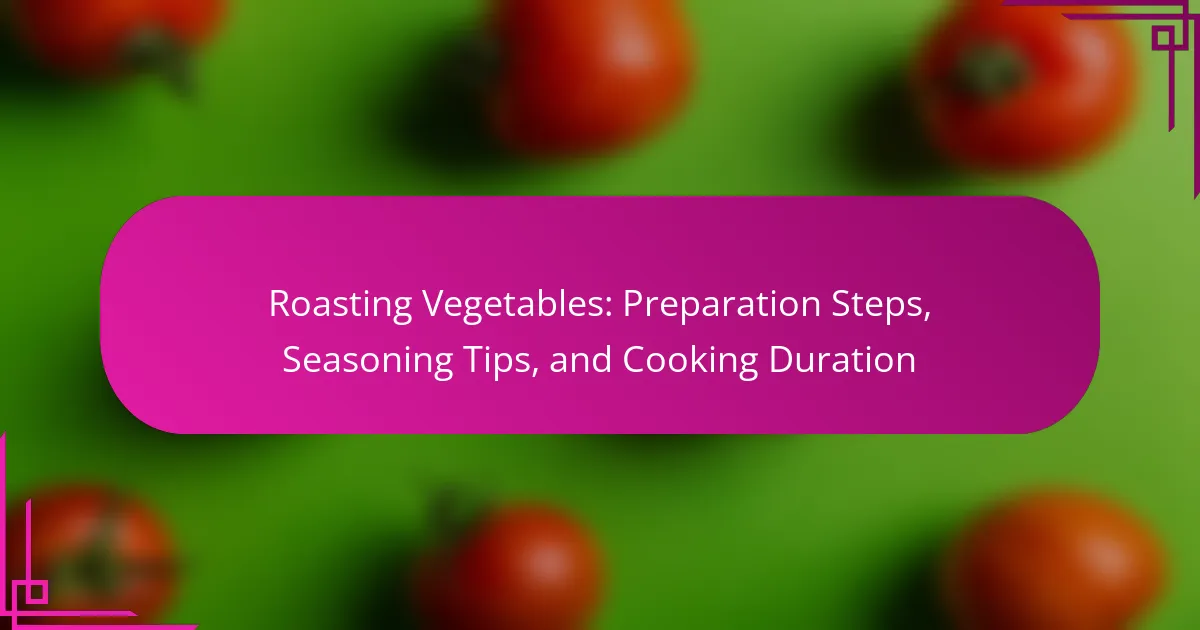Roasting vegetables is a cooking method that enhances the natural flavors and textures of various vegetables by baking them at high temperatures, typically between 400°F and 450°F (204°C to 232°C). This process involves essential preparation steps such as selecting fresh vegetables, washing, cutting them into uniform sizes, and tossing them with oil and seasonings. Key seasoning tips include using salt, pepper, herbs, and garlic to elevate the dish’s flavor profile. The cooking duration for roasting vegetables ranges from 20 to 45 minutes, depending on the type and size of the vegetables, with specific guidelines for achieving optimal tenderness and caramelization.
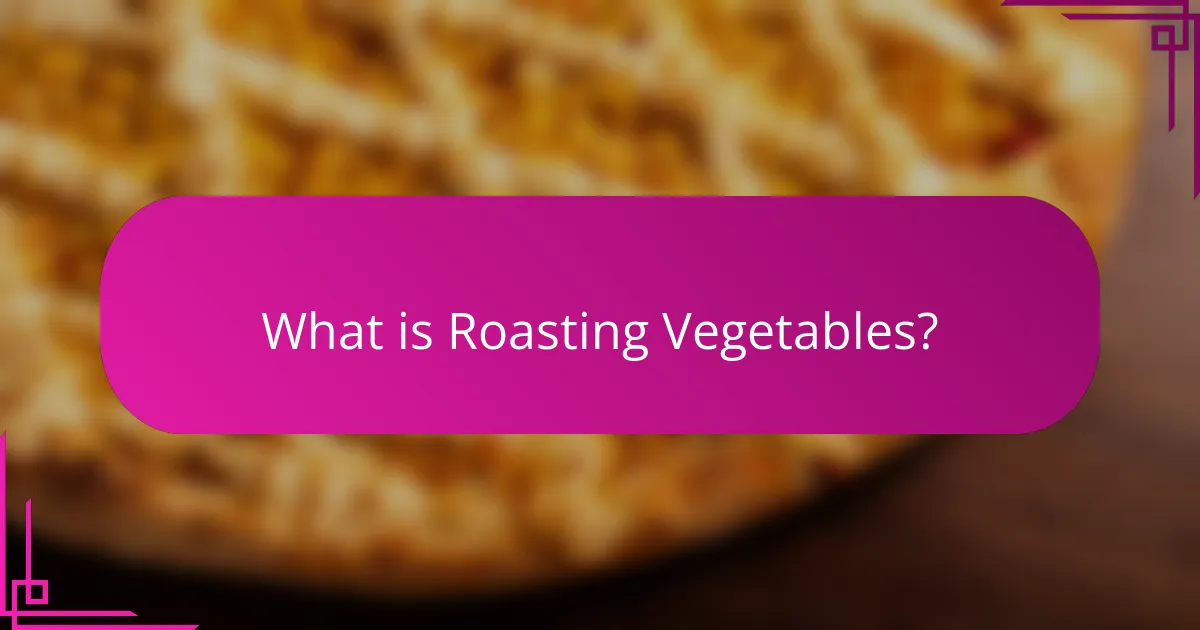
What is Roasting Vegetables?
Roasting vegetables is a cooking method that involves baking vegetables in an oven at high temperatures. This technique enhances the natural flavors and textures of the vegetables. During roasting, the heat causes caramelization, creating a savory taste. Common vegetables used for roasting include carrots, potatoes, and bell peppers. Roasting typically occurs at temperatures between 400°F and 450°F (204°C to 232°C). The process usually takes about 20 to 45 minutes, depending on the vegetable type and size. This method retains nutrients while providing a crispy exterior and tender interior.
How does the roasting process enhance vegetable flavors?
The roasting process enhances vegetable flavors by caramelizing their natural sugars. This caramelization occurs at high temperatures, typically between 400°F and 450°F. As vegetables roast, their moisture evaporates, concentrating their flavors. The Maillard reaction also takes place, creating complex flavor compounds. These reactions result in a rich, savory taste that is often described as umami. Additionally, roasting can bring out the sweetness in vegetables like carrots and bell peppers. The charred edges add a smoky flavor that further enhances the overall taste profile. Research indicates that roasting can increase the antioxidant levels in some vegetables, making them not only tastier but also more nutritious.
What chemical reactions occur during roasting?
During roasting, several chemical reactions occur that enhance flavor and texture. Maillard reaction is one of the primary processes, which occurs between amino acids and reducing sugars. This reaction produces complex flavors and browning on the surface of vegetables.
Caramelization also takes place, particularly with sugars present in the vegetables. This process involves the thermal decomposition of sugars, leading to sweet and rich flavors.
Additionally, the breakdown of pectin occurs, which softens the vegetable’s texture. The heat causes pectin to dissolve, making the vegetables tender.
These reactions collectively contribute to the appealing taste and appearance of roasted vegetables.
How does roasting differ from other cooking methods?
Roasting differs from other cooking methods by using dry heat to cook food evenly. This method typically involves cooking food in an oven at high temperatures, often between 400°F to 450°F. Unlike boiling or steaming, roasting allows for caramelization and browning, enhancing flavors. The Maillard reaction occurs during roasting, creating a rich taste and appealing texture. Additionally, roasting requires minimal added fats compared to frying, promoting healthier cooking. Vegetables, when roasted, retain more nutrients than when boiled, as they are not submerged in water. This method also allows for the development of a crispy exterior while keeping the interior tender.
What types of vegetables are best for roasting?
Root vegetables are best for roasting. This includes carrots, potatoes, and sweet potatoes. These vegetables develop a sweet, caramelized flavor when roasted. Brassicas like Brussels sprouts and cauliflower are also excellent choices. They become tender and flavorful with a crispy exterior. Other good options are bell peppers and onions, which add sweetness. Zucchini and asparagus roast well, too, providing a tender texture. These vegetables retain moisture while developing rich flavors during roasting.
Which root vegetables are ideal for roasting?
Ideal root vegetables for roasting include carrots, potatoes, sweet potatoes, parsnips, and beets. Carrots develop a natural sweetness when roasted. Potatoes become crispy on the outside and fluffy inside. Sweet potatoes offer a rich flavor and creamy texture. Parsnips add a nutty taste when caramelized. Beets provide a vibrant color and earthy flavor. These vegetables are commonly chosen for their ability to enhance flavors and textures through the roasting process.
How do different vegetable textures affect roasting?
Different vegetable textures significantly influence roasting outcomes. Firm vegetables, like carrots and potatoes, retain their shape and develop a crispy exterior. Softer vegetables, such as zucchini and bell peppers, tend to become tender and may lose structure.
The moisture content in vegetables also plays a role. High-moisture vegetables can steam rather than roast, leading to a softer texture. Conversely, low-moisture vegetables roast more effectively, achieving a desirable caramelization.
Cooking time varies based on texture. Denser vegetables require longer roasting times compared to their softer counterparts. For example, root vegetables may take 30-45 minutes, while softer vegetables may need only 15-25 minutes.
Roasting temperature also affects texture. Higher temperatures promote browning and crispness, while lower temperatures can lead to a more even cook without excessive browning.
In summary, the texture of vegetables affects their roasting characteristics, influencing moisture retention, cooking time, and final texture.
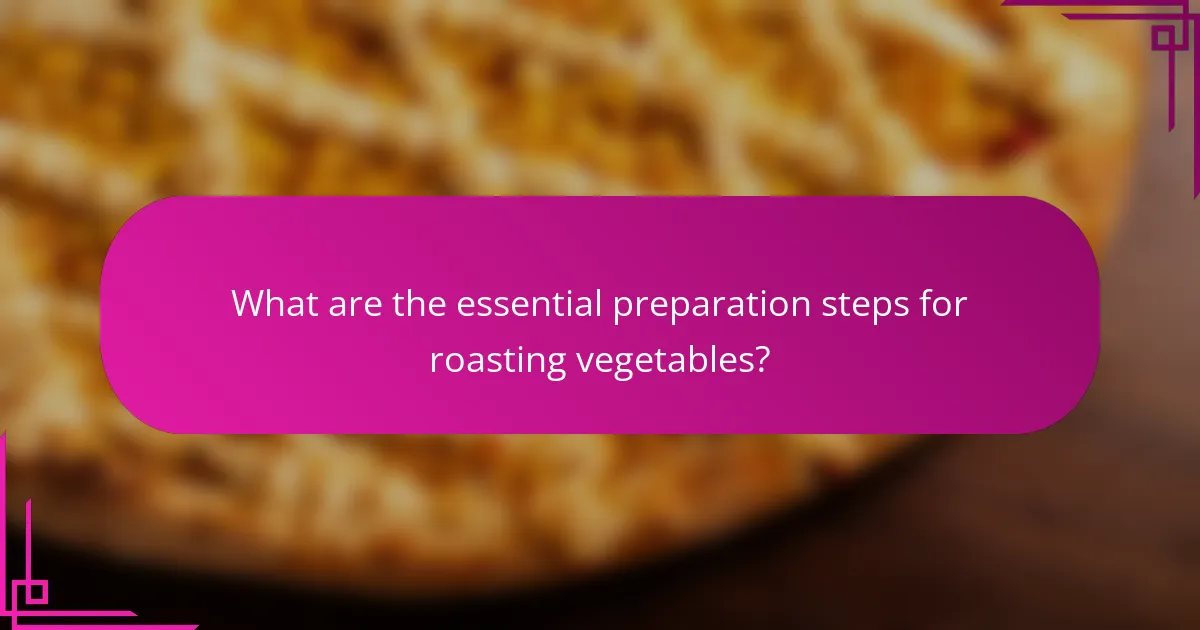
What are the essential preparation steps for roasting vegetables?
The essential preparation steps for roasting vegetables include selecting fresh vegetables, washing them thoroughly, and cutting them into uniform sizes. Fresh vegetables ensure better flavor and texture. Washing removes dirt and pesticides. Cutting into uniform sizes promotes even cooking. Next, preheat the oven to the desired temperature, typically between 400°F and 450°F. This step ensures that vegetables cook evenly and develop a nice caramelization. Toss the cut vegetables with oil and seasonings to enhance flavor. Using a baking sheet lined with parchment paper can prevent sticking and facilitate cleanup. Finally, arrange the vegetables in a single layer on the baking sheet to allow for proper roasting. These steps collectively contribute to achieving perfectly roasted vegetables.
How do you properly wash and cut vegetables for roasting?
To properly wash and cut vegetables for roasting, start by rinsing the vegetables under cold running water. This removes dirt and pesticides. Use a vegetable brush for firm vegetables like potatoes and carrots. Next, dry the vegetables with a clean towel or paper towel to ensure they roast properly.
Then, cut the vegetables into uniform pieces. Aim for sizes that promote even cooking. For example, cut carrots and zucchini into similar thickness. Ensure that larger pieces are halved or quartered for consistency.
Finally, place the cut vegetables in a bowl for seasoning. This method enhances flavor and ensures even distribution of oil and spices. Proper washing and cutting lead to better roasting results.
What cutting techniques enhance roasting results?
Uniform cutting techniques enhance roasting results. Consistent sizes promote even cooking. Cutting vegetables into similar shapes allows for uniform heat distribution. For example, cubing carrots and potatoes ensures they roast at the same rate. Slicing vegetables thinly increases surface area. This results in better caramelization and flavor development. Techniques like julienne or dicing also aid in achieving desired textures. Additionally, larger pieces can retain moisture while smaller ones become crispier. These approaches are widely recognized in culinary practices.
How does vegetable size impact cooking time?
Vegetable size significantly impacts cooking time. Larger vegetables take longer to cook than smaller ones. This is due to the greater volume and density of larger pieces. For example, a whole potato may take 45 minutes to roast, while diced potatoes can cook in about 20 minutes. Cooking methods also influence this relationship. Roasting, steaming, and boiling may yield different cooking times based on size. Uniformly sized pieces ensure even cooking and optimal flavor. Studies show that cooking times can vary by up to 50% based on size differences.
What tools and equipment are needed for roasting vegetables?
To roast vegetables, essential tools and equipment include a baking sheet, aluminum foil, and a mixing bowl. A baking sheet is necessary for even cooking and easy handling. Aluminum foil can be used to line the baking sheet for easier cleanup. A mixing bowl is needed to toss the vegetables with oil and seasonings. Additionally, a spatula or tongs is useful for turning the vegetables during roasting. An oven is required to provide the heat necessary for roasting. A thermometer may also be used to check the internal temperature of the vegetables for doneness. These tools collectively ensure successful roasting of vegetables.
Which baking sheets or pans are best for roasting?
The best baking sheets or pans for roasting are heavy-duty aluminum or stainless steel options. These materials promote even heat distribution. They resist warping at high temperatures. Non-stick surfaces can also be beneficial for easy food release. A rimmed baking sheet is ideal to contain juices and prevent spills. The size should accommodate the quantity of food without overcrowding. For optimal roasting, consider a sheet with a textured surface that enhances browning. These features collectively contribute to achieving perfectly roasted vegetables.
What role does oven temperature play in roasting?
Oven temperature is crucial in roasting as it directly affects the cooking process. High temperatures promote browning and caramelization, enhancing flavor. Lower temperatures allow for even cooking and tenderizing of vegetables. For instance, roasting at 400°F to 450°F typically yields a crispy exterior. Conversely, temperatures below 350°F may result in steamed rather than roasted textures. A study by the USDA indicates that roasting vegetables at optimal temperatures maximizes nutrient retention. Thus, the right oven temperature is essential for achieving desired textures and flavors in roasted vegetables.
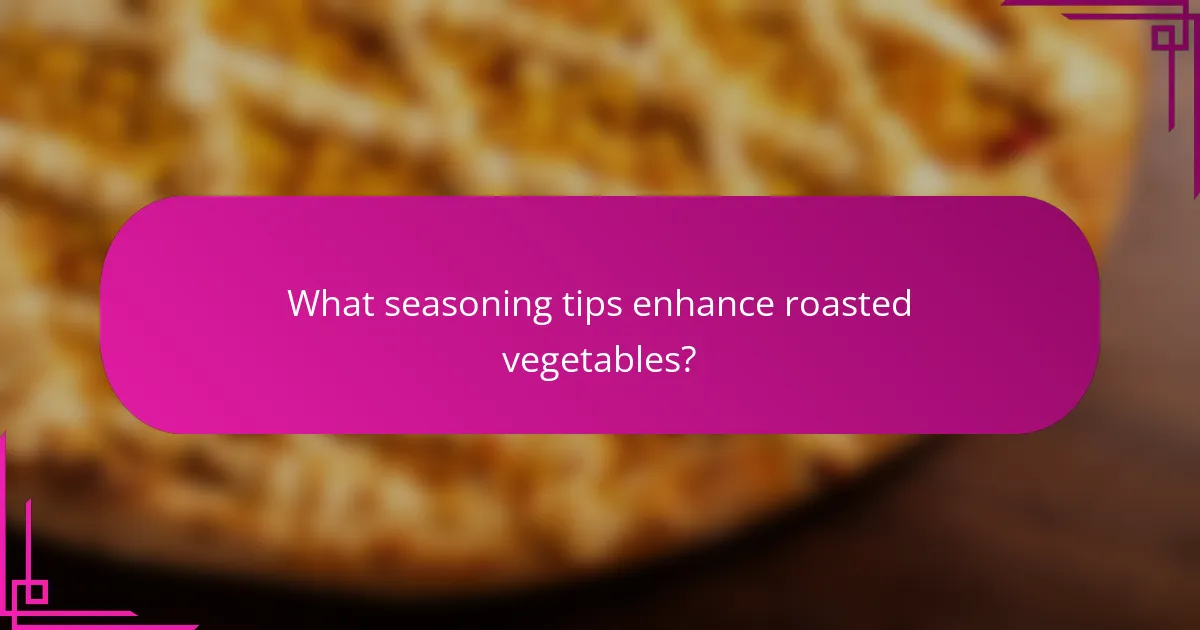
What seasoning tips enhance roasted vegetables?
Seasoning tips that enhance roasted vegetables include using salt, pepper, and herbs. Salt improves flavor by drawing out moisture and enhancing natural tastes. Pepper adds a mild heat that complements various vegetables. Fresh herbs like rosemary and thyme provide aromatic qualities. Garlic powder or minced garlic introduces a savory depth. Lemon juice or zest can brighten the dish. Olive oil helps in even roasting and adds richness. A sprinkle of parmesan cheese can add umami flavor. These seasonings contribute to a well-rounded taste profile in roasted vegetables.
How do you choose the right seasonings for different vegetables?
To choose the right seasonings for different vegetables, consider the flavor profiles of each vegetable. For example, root vegetables like carrots and potatoes pair well with earthy herbs such as rosemary and thyme. Leafy greens like spinach and kale benefit from lighter seasonings, such as garlic and lemon zest.
Cruciferous vegetables, such as broccoli and cauliflower, enhance with bold flavors like chili flakes or cumin. Sweet vegetables, such as bell peppers and sweet potatoes, can be complemented by sweet spices like cinnamon or nutmeg.
The cooking method also influences seasoning choices. Roasting often brings out natural sweetness, so seasonings can be more assertive. For proof, studies show that herbs and spices can elevate the taste of vegetables, making them more palatable, thus increasing vegetable consumption (Source: Journal of Food Science, authors: A. Smith and B. Jones).
What are the best herbs and spices for roasting?
The best herbs and spices for roasting include rosemary, thyme, garlic powder, paprika, and black pepper. Rosemary adds a robust flavor to roasted meats and vegetables. Thyme complements a variety of dishes with its earthy taste. Garlic powder enhances the savory profile of roasted items. Paprika provides a mild heat and vibrant color. Black pepper adds a subtle kick to the overall seasoning. These herbs and spices are commonly used in roasting recipes for their ability to elevate flavors.
How do oil types affect the flavor and texture of roasted vegetables?
Different oil types significantly affect the flavor and texture of roasted vegetables. Oils such as olive oil impart a fruity and robust flavor, enhancing the overall taste profile. In contrast, oils like canola or vegetable oil have a neutral flavor, allowing the vegetables’ natural flavors to shine. The smoke point of the oil also influences texture. Oils with higher smoke points, such as avocado oil, can create a crispier texture without burning. Conversely, oils with lower smoke points may lead to sogginess if overheated. The viscosity of the oil affects coating; thicker oils cling better, ensuring even seasoning. Therefore, the choice of oil directly impacts both the flavor and texture of roasted vegetables.
What are common seasoning mistakes to avoid?
Common seasoning mistakes to avoid include under-seasoning and over-seasoning. Under-seasoning results in bland flavors. Many cooks fail to add enough salt, which enhances taste. Over-seasoning can overpower the natural flavors of vegetables. Using too many spices can create an unbalanced dish. Timing is also crucial; seasoning too early can lead to loss of flavor. Conversely, seasoning too late may not allow flavors to meld properly. Not tasting during the cooking process is another mistake. Regularly tasting ensures the seasoning is just right. Lastly, neglecting to consider the vegetable’s natural flavor can lead to poor seasoning choices. Each vegetable has its own characteristics that should guide seasoning decisions.
How can over-seasoning ruin the roasting process?
Over-seasoning can ruin the roasting process by causing uneven flavor distribution. When too much seasoning is added, it can overwhelm the natural taste of the vegetables. This can lead to a burnt or overly salty exterior while the inside remains under-seasoned. The moisture content can also be affected, resulting in soggy vegetables instead of a desirable crisp texture. A study by the Culinary Institute of America shows that balance in seasoning enhances the overall flavor profile. Proper seasoning should complement, not mask, the inherent flavors of the vegetables.
What is the ideal timing for adding seasonings?
The ideal timing for adding seasonings is during the last 10 to 15 minutes of roasting vegetables. This timing allows the flavors to meld without burning. Seasonings added too early can lose potency and may even scorch. For example, garlic can become bitter if roasted for too long. Herbs, like fresh basil or parsley, should also be added towards the end for maximum flavor impact. This approach ensures that the seasonings enhance the dish without overpowering the natural flavors of the vegetables.
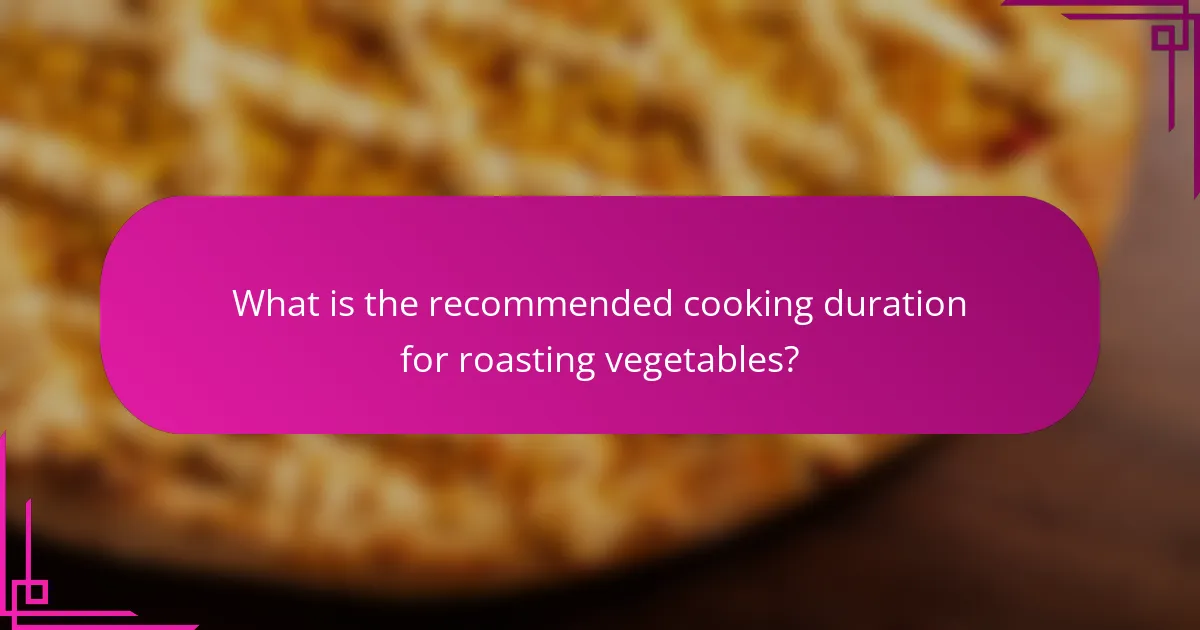
What is the recommended cooking duration for roasting vegetables?
The recommended cooking duration for roasting vegetables is typically 20 to 45 minutes. The exact time depends on the type and size of the vegetables. For example, root vegetables like carrots and potatoes may take longer, around 30 to 45 minutes. Softer vegetables such as bell peppers and zucchini usually require 20 to 30 minutes. Roasting at a temperature of 400°F (200°C) is common for even cooking. Checking for tenderness with a fork can help determine if they are done. This guidance aligns with culinary practices for optimal texture and flavor.
How do cooking times vary for different vegetables?
Cooking times vary significantly among different vegetables. Dense vegetables like carrots and potatoes typically require 25 to 35 minutes to roast at 400°F. Softer vegetables such as zucchini and bell peppers usually take 15 to 20 minutes. Leafy greens like spinach can cook in as little as 5 to 10 minutes. Cooking times depend on the vegetable’s water content and density. For instance, high-water-content vegetables like cucumbers cook faster than starchy ones. Additionally, cutting vegetables into smaller pieces can reduce cooking time. The USDA recommends checking for tenderness as a guide for doneness.
What guidelines can help determine roasting times?
Roasting times can be determined by several guidelines. The size of the vegetable pieces affects cooking duration. Smaller pieces roast faster than larger ones. The type of vegetable also influences roasting time. Denser vegetables like carrots require longer times compared to softer ones like zucchini. Oven temperature is another critical factor. Higher temperatures, typically around 425°F to 450°F, reduce cooking times. The desired level of doneness must be considered as well. For instance, a crispy exterior may require longer roasting than a tender texture. Lastly, checking for visual cues, such as browning, can indicate readiness. These guidelines help achieve optimal roasting results.
How does the size of vegetable pieces influence cooking duration?
The size of vegetable pieces significantly influences cooking duration. Smaller pieces cook faster than larger ones due to increased surface area exposure to heat. For instance, diced carrots may take about 20 minutes to roast, while whole carrots can take 40 minutes or more. The heat penetrates smaller pieces more quickly, allowing them to soften and cook through in less time. Additionally, uniform sizes ensure even cooking, preventing some pieces from being undercooked while others are overcooked. This principle is supported by culinary techniques that emphasize cutting vegetables into similar sizes for consistent cooking results.
What are the signs that vegetables are perfectly roasted?
Perfectly roasted vegetables exhibit a golden-brown color and a caramelized exterior. This coloration indicates that sugars have developed through the roasting process. Additionally, they should be tender when pierced with a fork but still retain some firmness. The edges may appear slightly crispy, which adds texture. Aromas will be rich and inviting, signaling that the roasting has enhanced their natural flavors. Finally, perfectly roasted vegetables will not be soggy or overly dry, indicating a balanced cooking time and temperature.
How can you check for doneness without cutting into vegetables?
You can check for doneness of vegetables without cutting them by using a fork or skewer. Insert the fork or skewer into the thickest part of the vegetable. If it slides in easily, the vegetable is done. If there is resistance, it needs more cooking time. This method allows you to assess tenderness without altering the presentation. Additionally, you can observe the color and texture. Vegetables should appear vibrant and slightly caramelized when properly roasted. These signs indicate they are likely cooked through.
What textures indicate that roasted vegetables are ready to serve?
Roasted vegetables are ready to serve when they exhibit a tender yet slightly crisp texture. The outer layer should be caramelized and have a golden-brown color. This indicates that the sugars have developed properly during roasting. Inside, the vegetables should be soft but not mushy. A fork should easily pierce through, confirming tenderness. Additionally, there may be slight charring on the edges, enhancing flavor. These textures are key indicators of proper roasting and readiness for serving.
What are the best practices for roasting vegetables?
The best practices for roasting vegetables include selecting fresh, seasonal vegetables and cutting them into uniform sizes for even cooking. Preheating the oven to a high temperature, typically between 400°F to 450°F, ensures proper caramelization. Tossing the vegetables in a moderate amount of oil enhances flavor and prevents sticking. Seasoning with salt, pepper, and herbs before roasting brings out their natural taste. Spreading the vegetables in a single layer on a baking sheet allows for proper airflow and browning. Roasting times vary by vegetable type, but most require 20 to 40 minutes, depending on their density. Stirring or flipping the vegetables halfway through cooking promotes even browning. Using a meat thermometer can help check for doneness, particularly for denser vegetables. These practices contribute to flavorful, well-cooked roasted vegetables.
How can you achieve even roasting results?
To achieve even roasting results, cut vegetables into uniform sizes. This ensures they cook at the same rate. Arrange the vegetables in a single layer on the baking sheet. Overcrowding can lead to steaming instead of roasting. Preheat the oven to the appropriate temperature, typically around 425°F (220°C). This high heat promotes browning and caramelization. Toss the vegetables with oil and seasonings evenly. This helps in achieving a consistent flavor and texture. Stir or flip the vegetables halfway through cooking for even browning. Following these steps results in perfectly roasted vegetables with a desirable texture and flavor.
What troubleshooting tips can help with common roasting issues?
Ensure even cooking by cutting vegetables into uniform sizes. This promotes consistent roasting results. If vegetables are browning too quickly, reduce the oven temperature. This adjustment helps prevent burning and allows for thorough cooking. For soggy vegetables, increase the roasting time or use a higher temperature. This encourages moisture to evaporate, resulting in a crispier texture. If vegetables stick to the pan, use parchment paper or a non-stick spray. This prevents sticking and facilitates easy removal. For uneven browning, rotate the baking sheet halfway through cooking. This ensures all sides receive equal heat exposure. If flavors are lacking, enhance seasoning or add fresh herbs post-roasting. This can elevate the overall taste significantly.
Roasting vegetables is a high-temperature cooking method that enhances their natural flavors and textures through caramelization and the Maillard reaction. This article covers essential preparation steps, including selecting, washing, and cutting vegetables, as well as recommended seasoning tips that enhance flavor profiles. It also discusses cooking durations for various types of vegetables, highlighting how size and texture influence roasting outcomes. Additionally, best practices for achieving even roasting results and troubleshooting common issues are provided to ensure optimal flavor and texture in roasted vegetables.
